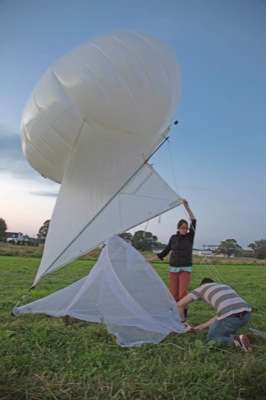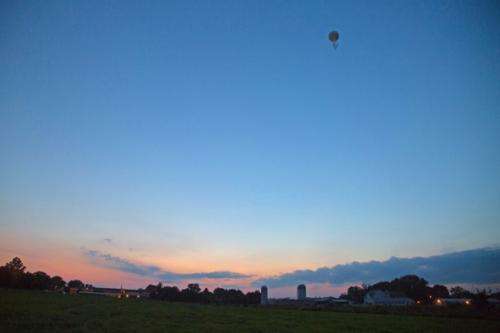Researchers track fall migratory patterns of insects

To study the nocturnal flight patterns of migrating insects during the fall, researchers at the University of Delaware have been spending their nights on the Newark Farm launching a balloon equipped with a tow net to try to catalogue insect species.
Jeff Buler, assistant professor, and Charles Mason, professor, both in the Department of Entomology and Wildlife Ecology, have teamed up for a pilot study on migrating insects during the fall, something that has not been well researched in the United States.
The professors are being assisted on the project by Matt Levondosky, a UD alumnus who was a wildlife ecology major, and Michael Palmer, a senior chemical and biomolecular engineering major who was brought into the project after taking an entomology course with Mason.
Buler said the study has been a nice mix of disciplines from within the department.
"I mostly study birds and bird migration but our department has a number of entomologists, so this is a nice collaboration between the wildlife ecologists and the entomologists," he said.
To conduct the study, the researchers used a large balloon known as a helikite – a special kite with a helium filled balloon on loan from UD's Department of Geography—with a tow net that has a catch bag at the end acting as a one-way funnel into which insects fly.
The balloon has been launched around sunset on the Newark Farm, between the Allen Laboratory and the apiary, where it flies for four hours. It is launched at that time because both insects and birds initiate their nocturnal flights around civil twilight, which is about 40 minutes after sunset.
Buler is leading the pilot project and said he was interested in the study because he uses radar to track bird migration and one of the biggest obstacles he faces in analyzing data is whether he is seeing insects or birds on the radar.

Usually, researchers who use radar to track bird migration use the air speeds of biological targets to differentiate between birds and insects.
"Birds are stronger fliers than insects so they're generally moving at faster air speeds than the insects, which tend to act more like aerial plankton, just barely moving faster than the ambient wind speeds. That's how we distinguish birds from insects on the radar, but we'd like to be able to collect some data to validate what we think we're seeing," Buler said. "That's why I'm trying to sample to see if on those nights that we do see insects, we are also catching insects."
Another reason for the study is that while insect migration has been widely studied in the spring, where pest insects can pose a problem for crops, it has not been very well studied in the U.S. in the fall.
In other places around the world—specifically China, India and Europe—entomologists have studied the fall migrations of insects closely. To get the UD study off the ground, Buler said the team relied heavily on those studies to learn how to utilize the balloon properly.
"A colleague I've been in contact with is Jason Chapman, who is a British entomologist, and he had a nice paper come out recently looking at the convergence of behavior between insects and birds," said Buler. "Birds tend to be not as picky about the winds and they just sort of fly on most nights. Because of their own power, they can contend with the winds and get to where they want to go. But because insects are such weak fliers, they seem to be very choosy about the wind."
Chapman and his collaborator Don Reynolds, another British entomologist, helped Buler's team with the aerial trapping system.
"They have a very similar sort of aerial trapping system in which they use a helium balloon to lift a net and they sent me their schematic, which was the inspiration for us to build our own. I've been in contact with them and they're excited about it because they said that nobody in North America has really done much and they're interested in what we might find," said Buler.
One problem the team members have encountered has been their inability to get the balloon as high as they want.
"We're limited by how high we can fly. It can fly up to 500 feet, which is fine because there should be insects at that height, but its also likely that there are a bunch of insects above that height. But we're getting far enough off the ground that we're probably sampling this layer of insects in the air above the ground," said Buler.
The insects that they have catalogued so far include a noctuid moth, the green cloverworm, which Doug Tallamy, professor in the Department of Entomology and Wildlife Ecology, helped them identify.
Buler said the green cloverworm was interesting because it is a species that is known to winter along the Gulf Coast and migrate north in the spring, so it is likely that it was moving south through this area with the approach of fall.
As for the next steps for the project, Buler said he hopes to conduct the study again next fall.
"I'm more interested in the fall migration mostly because that's less well studied," he said.
Provided by University of Delaware
















